The Kingston A1000 NVMe SSD Review: Phison E8 Revisited
by Billy Tallis on July 2, 2018 8:00 AM ESTAnandTech Storage Bench - Light
Our Light storage test has relatively more sequential accesses and lower queue depths than The Destroyer or the Heavy test, and it's by far the shortest test overall. It's based largely on applications that aren't highly dependent on storage performance, so this is a test more of application launch times and file load times. This test can be seen as the sum of all the little delays in daily usage, but with the idle times trimmed to 25ms it takes less than half an hour to run. Details of the Light test can be found here. As with the ATSB Heavy test, this test is run with the drive both freshly erased and empty, and after filling the drive with sequential writes.
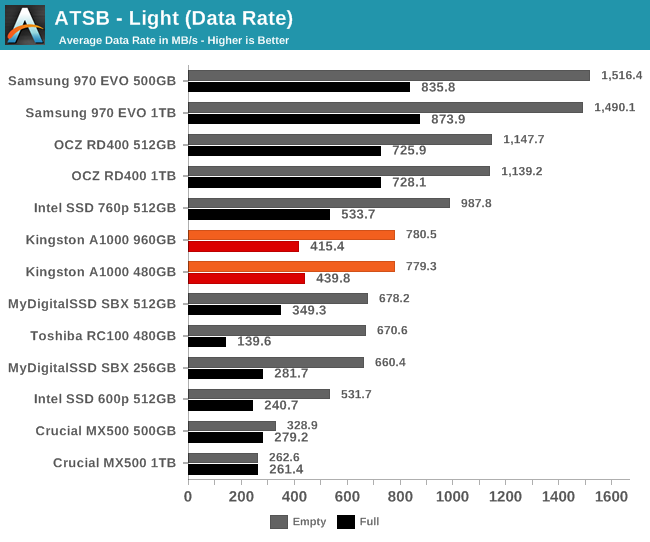
The average data rates from the Kingston A1000 on the Light test are a step up from the MyDigitalSSD SBX, both when the test is run on an empty drive and when the drive is full. The A1000 is clearly quite a bit faster than SATA drives, but for workloads this light the difference won't be very noticeable.
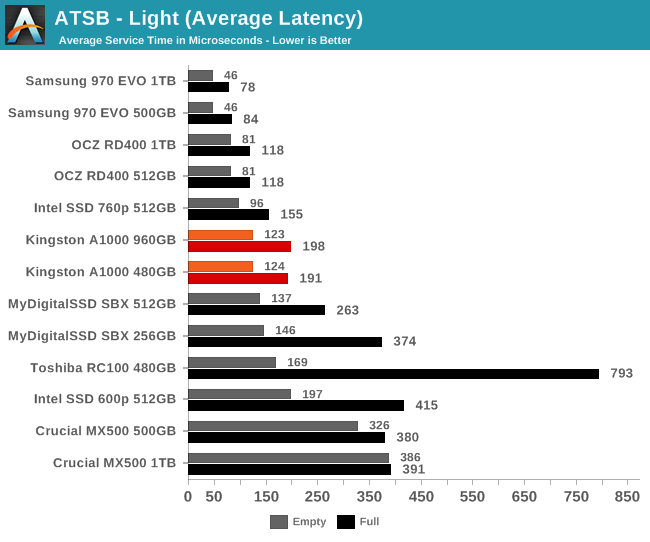

The extra spare area of the A1000 as compared with the SBX shows up clearly in the impact on full-drive latency, especially the 99th percentile latency. The A1000 has great QoS that looks much more like that of a high-end NVMe.
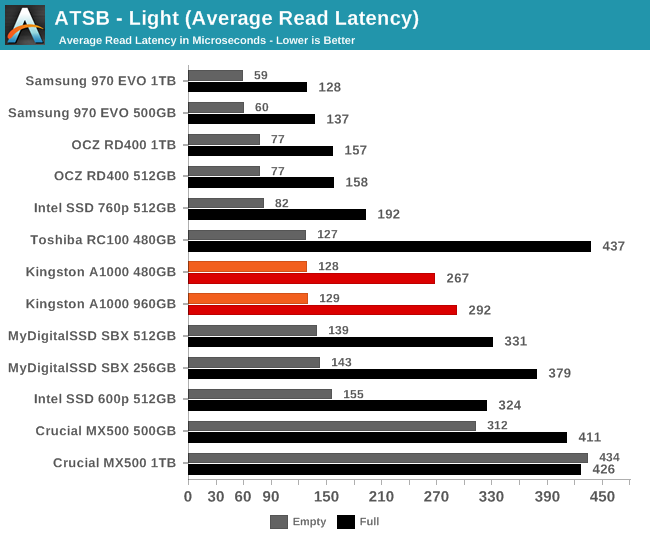
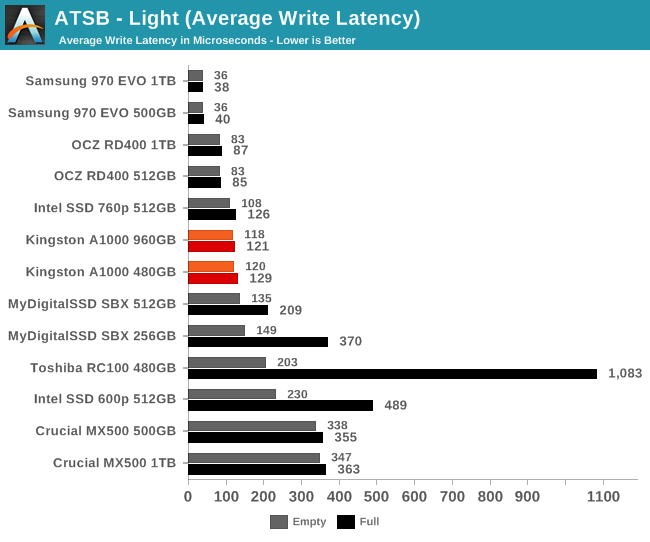
The average read latencies from the Kingston A1000 don't particularly stand out from the competition, but the average write latency is clearly better than other low-end NVMe SSDs, especially when the test is run on a full drive.
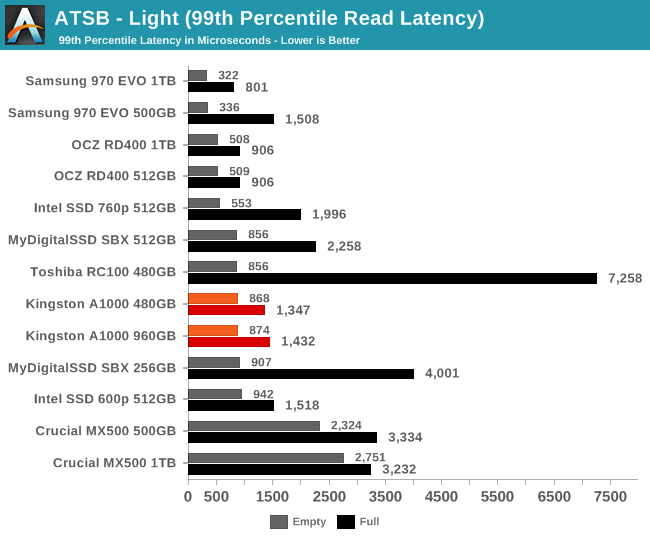

The 99th percentile read and write latency scores amplify the full-drive performance advantage of the Kingston A1000, to the point that even the read latency is noticeably better than its closest competition, and the write QoS is quite good.
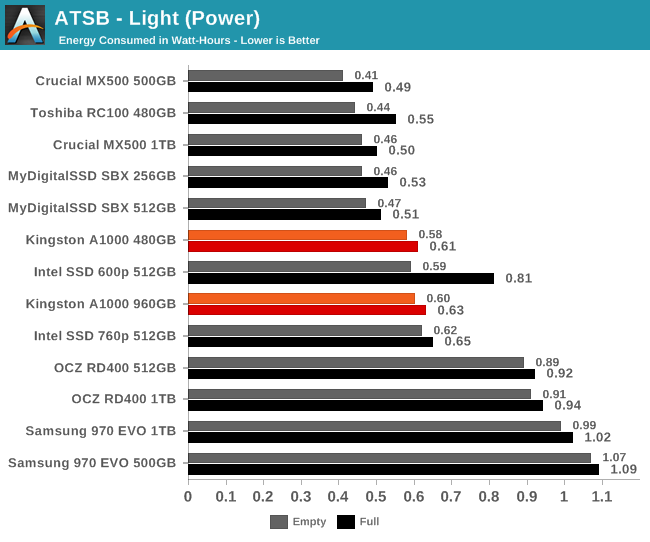
The MyDigitalSSD SBX and Toshiba RC100 were able to more or less match the Crucial MX500 SATA SSD for energy usage on the Light test, but the Kingston A1000 doesn't do as well. It is still more efficient than most NVMe drives, but not remarkably so.










26 Comments
View All Comments
romrunning - Monday, July 2, 2018 - link
Any NVMe drive that doesn't beat the Intel 600p in every category shouldn't be made. I really wish all mfgs would keep NVMe drives to at least PCI x4 & 8 channels with a minimum performance level that is much higher than SATA. The bar for the next tech level of storage products should be at a higher level than the previous.Forget the low-end marked for NVMe. SATA can easily take care of any needs there.
peevee - Monday, July 2, 2018 - link
Given that only Samsung barely saturates PCIex2, and only on artificial tests, at this point even x4 is useless, let alone x8. They'll need many more channels.Actually, I'd prefer x1 for ultra-low-power, if it is fully saturated in more or less real-life tests (like AT's "Light"), vs x4 which only saturates 1/10th of x1 capacity.
romrunning - Tuesday, July 3, 2018 - link
I was thinking more along the lines of every mfg creating NVMe drives have to attain to a minimum performance level. It becomes easier to understand what is higher-performing from the end-user's perspective. So if NVMe's minimum performance level is 2x SATA, then anytime you see NVMe you know it's better than SATA. Too bad whatever storage consortium finalized specs for NVMe didn't require min perf levels for storage.It's annoy to me when these mfgs put out "new" drives that don't exceed the older tech.
FunBunny2 - Monday, July 2, 2018 - link
" I really wish all mfgs would keep NVMe drives to at least PCI x4 & 8 channels with a minimum performance level that is much higher than SATA. "some wag put it, "you sell the sizzle, not the steak".
Gunbuster - Tuesday, July 3, 2018 - link
Okay Kingston, reviews are done, feel free to swap in cheaper/slower NAND chips. ;)Ratman6161 - Tuesday, July 3, 2018 - link
In the ATSB Heavy Data Rate chart, for the 1TB 970 EVO, I think you have the full and empty numbers transposed. I.e. you show 525 empty and 635 full. I assume that should be 635 empty and 525 full?Billy Tallis - Tuesday, July 3, 2018 - link
They're not transposed. I'm not sure what happened with those test runs, but I'm re-running them. I do know that Samsung drives lie about when they've finished a secure erase, so it's possible the "empty" drive test run was still working on an erase operation in the background even though I try to ensure all drives have plenty of idle time to finish cleaning up after they claim to be done erasing.leexgx - Wednesday, July 4, 2018 - link
Surprised it works like that when using secure erase, zapping page area and all NAND chips should not take long to do, also what can i use to use secure erase on all drives (seagate own tool seems to lack it, it has full erase but it's not secure erase and it killed my seagate firecuda doing it)SanX - Tuesday, July 3, 2018 - link
Everyone here knows that in the shops the average Joe will see on the product tag "Sequential Read 1500 MB/s" which is plain lie and conveniently keeps mum about this. Which test gives 1500, show me? At best 2-3 times less.This site degraded long ago to serve salespeople.
rocky12345 - Wednesday, July 4, 2018 - link
Great review but this drive does seem rather unimpressive for sure. It acts like it doe snot have a dram cache at all since most if it's scores are well below the mark. I like Kingston for their memory products which work well in the systems I build for my clients. These NVMe drives that are considered lower end give a false picture of great speed and performance because NVMe drives are known for their great performance level. Then you get these drives trying to break into this sector and do not perform any where close to what you would expect from a NVMe drive. Heck my samsung 860 Pro 512GB Sata SSD can get better numbers in a lot of the tests done in the review than these cheap low end NVMe drives and it is only based off of the Sata port and limited to a max 600MB's from the port itself that is kinda sad if you think about it really.